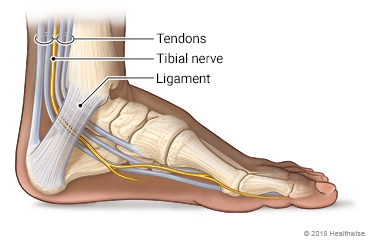

Tissue that is compressing the nerve may be removed and the ankle is flexed and extended to ensure that the nerves and tendons that pass through the tarsal tunnel move freely. Tarsal tunnel syndrome is compression or squeezing on the posterior tibial nerve at the inner aspect of the ankle. An incision is made on the inside of the ankle, and the nerves and the tarsal tunnel are examined for abnormalities. Diagnosis can be suspected clinically with burning plantar foot pain with a positive Tinel's sign over the tibial nerve. Surgery may be recommended for people that have progressive symptoms or weakness that does not respond to conservative treatment. Tarsal Tunnel Syndrome is a compressive neuropathy of the tibial nerve at the level of the tarsal tunnel which can lead to pain and paresthesias of the plantar foot. This is the area where all muscles, bones, ligaments, tendons, and nerves enter the foot. It’s important to understand that the area of the heel and ankle is very complex. Non-steroidal anti-inflammatory medications may be prescribed. Tarsal tunnel syndrome is caused by the entrapment or compression of the posterior tibial nerve.

Steroid injections in or near the tarsal tunnel may relieve symptoms. A temporary cast may be prescribed to immobilize the ankle and allow the inflamed tissues to heal. Tarsal tunnel syndrome results in peripheral nerve entrapment much less often than carpal tunnel syndrome or cubital tunnel syndrome.1Previous investigations contain reports of cases involving no more than about 50 feet.1-8 The aetiological causes of the tarsal tunnel syndromes are mainly the presence of a ganglion. Treatment begins with modification of activities that may be contributing to the symptoms. Severe tarsal tunnel syndrome can cause muscle weakness and complete loss of movement or sensation in the foot. Symptoms of tarsal tunnel syndrome include burning and/or tingling sensation, numbness, and pain in the first three toes, the sole of the foot, the heel, and/or the ankle. The tarsal tunnel is located on the inside of the ankle, and is formed by the ankle bones and the band of ligaments that stretches across the foot. The tarsal tunnel is behind the bony bump on the inside of the ankle, and is made up of bone on the inside and a band of fibrous tissue on the outside. It has a bony floor and the flexor retinaculum forms the roof (Figure. This nerve is called the posterior tibial nerve. The tarsal tunnel is a fibro-osseous tunnel located behind and below the medial malleolus. Tarsal tunnel syndrome describes a condition where the tibial nerve - which runs down the inside of the lower leg and passes through the tarsal tunnel - is compressed due to injury or inflammation. Tarsal tunnel syndrome is a chronic injury caused by compression, or squeezing, of the nerve that travels to the bottom of your foot.


 0 kommentar(er)
0 kommentar(er)
